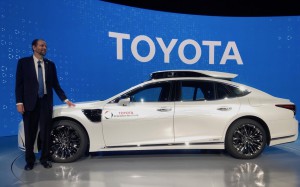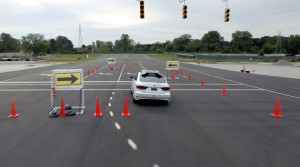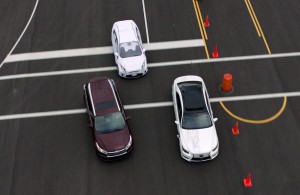
Toyota's tech chief Gil Pratt is talking with other automakers about using the company's Guardian technology.
While tires may blow out and steering systems might fail, drivers are responsible for at least 90% of all motor vehicle accidents, according to federal data. But what if a vehicle can be equipped with a digital safety system that is constantly watching what the human driver does, ready to step in to correct a potentially dangerous mistake?
That’s the idea behind the Guardian technology Toyota aims to have ready for production by early in the coming decade. Unlike autonomous, or even semi-autonomous driving systems, Guardian isn’t meant to replace the driver but simply wait on vigilant standby, ready to step in and reduce the risk of a crash.
Toyota is so confident about the strategy it has been meeting with competitors to see if they might be interested in using Guardian on their own vehicles, Gil Pratt, head of the Toyota Research Institute, announced during an appearance at the Consumer Electronics Show in Las Vegas.
The idea behind Guardian is “amplifying, rather than replacing” the human driver, Pratt explained, adding that the technology is not only meant to improve safety but that it also “can make it more fun to drive” by helping a motorist maneuver around tight corners, for one thing.
(Toyota introducing new automated test vehicle in Las Vegas. Click Here for the story.)
There already are a number of advanced driving assistance systems, or ADAS technologies, meant to prevent driver errors, such as blind-spot detection and forward collision warning with automatic emergency braking. And the industry is working on full hands-off systems that will essentially take control of the vehicle entirely.

Toyota's Guardian system waits in the background then activates to help drivers navigate hazards more quickly.
Guardian takes a different approach Pratt explained during a roundtable meeting with reporters. While it shares many of the same radar, camera and other sensors used by ADAS and autonomous systems, the new Toyota technology is designed to operate in the background where it constantly observes what the driver is doing, as well.
Guardian, Pratt explained, “is not a discrete on/off switch,” like auto-braking systems, “but a seamless blend of man and machine.”
The key difference between Guardian and other digital safety technologies is that it is constantly watching not only what’s happening on the road but also what the driver is doing. It can tell if a motorist is drowsy or distracted, and it can then “correct the mistakes of the human,” added Ryan Eustice, Toyota’s director of Automated Driving.
(Click Here for more about TDB’s first drive in the 2019 Toyota Prius AWD.)
The Japanese automaker offered several illustrations of how Guardian could work. In one, it stepped in to help a driver maneuver through a construction site. With the system off, the driver hit several cones. With it on, the car safely avoided all the obstacles.
Another video captured a real-world crash involving one of Toyota’s autonomous research vehicles, another driver setting off a multi-vehicle collision when he swerved out of his lane. In a computer simulation of that incident, Guardian was able to detect the situation before the driver, accelerating out of harm’s way automatically.
“It doesn’t guarantee there’ll be no crash,” stressed Pratt. “It’s not a miracle. But, in many, many cases … the system knows how to drive better than the human.”
The idea of offering breakthrough technology to competitors is rare but not unique. Volvo encouraged the rest of the industry to adopt its original seatbelt concept, for example. More recently, Tesla opened up a number of its patents for competitors to use, CEO Elon Musk explaining that it would help increase demand for electric vehicles and, in the process, help boost Tesla sales.
(To see more about the new 2020 Toyota Corolla, Click Here.)
Pratt wouldn’t say whom Toyota is talking to, though he did note that it has met with “a number” of other companies about sharing Guardian. Toyota is still trying to work up a strategy for such an approach which could mean licensing the system or possibly selling competitors a black box solution. Whatever approach it settles on, Guardian isn’t expected to be ready for production until early in the coming decade.

